No matter how much they claim the opposite, the gluingwallpaper without visible joints is determined not only by the skills of the master. A good result when pasting wallpaper end to end can be achieved without being a professional and even without making significant efforts. But for this you will have to find out some nuances.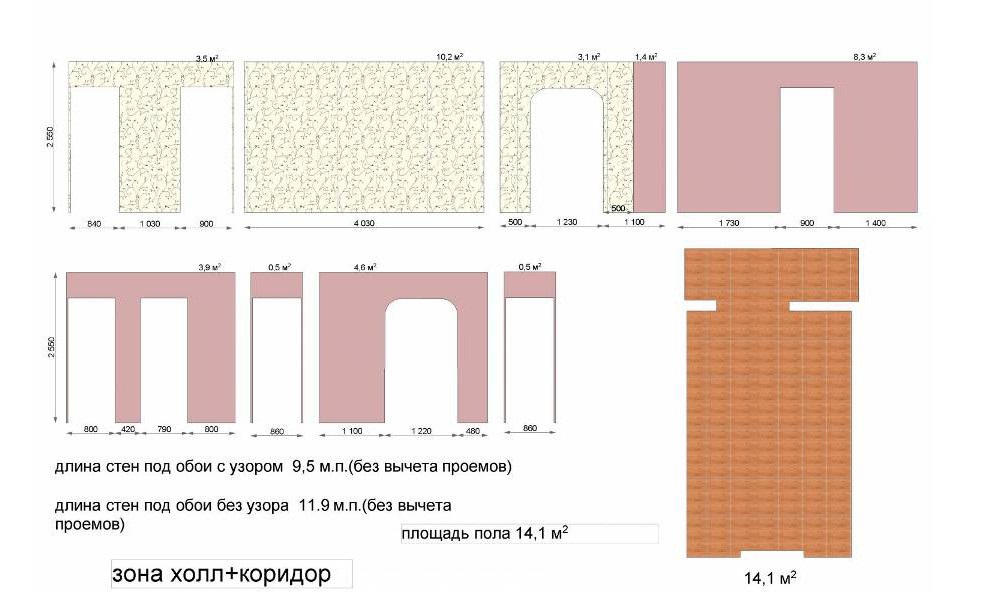 Scheme for calculating wallpaper for a room.Experts claim that the results of pasting are affected by: 70% - the quality of the wallpaper itself and 30% - the skill of the performer. There are quite a few situations when joints are formed, no matter how much effort is put into leveling them. And it is not about skill at all. Pasting technology can be carried out according to the rules, but the properties of the purchased type of wallpaper will affect. This fact should be accepted as a given. By the way, the price of a roll is not always a guide to quality. These nuances should be taken into account. Therefore, it would not be superfluous to arm yourself with some information when starting to choose a material.
Scheme for calculating wallpaper for a room.Experts claim that the results of pasting are affected by: 70% - the quality of the wallpaper itself and 30% - the skill of the performer. There are quite a few situations when joints are formed, no matter how much effort is put into leveling them. And it is not about skill at all. Pasting technology can be carried out according to the rules, but the properties of the purchased type of wallpaper will affect. This fact should be accepted as a given. By the way, the price of a roll is not always a guide to quality. These nuances should be taken into account. Therefore, it would not be superfluous to arm yourself with some information when starting to choose a material.
What to look for when choosing wallpaper?
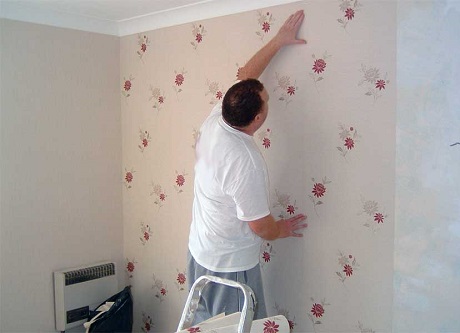 To make the joints on the surface less noticeable, it is recommended to paint the areas of the intended seams with paint of the corresponding shade.
To make the joints on the surface less noticeable, it is recommended to paint the areas of the intended seams with paint of the corresponding shade.
Edges.If the wallpaper you like is dark, look at its edges. There should not be a narrow strip of a light shade on them. The width of such a strip is insignificant, but it will noticeably mark the joints. And when two sheets are placed side by side, the width of the light stripes increases. Light edges are a manufacturing defect, and quite common. Experts assure that even expensive wallpaper can have such a defect. Therefore, we emphasize once again that the price of the material is not the parameter that you should pay attention to when choosing.
A relief surface. All wallpapers are of two categories: smooth or relief. The first are quite demanding on the evenness of the base. If the walls are not plastered and have irregularities, they will not disguise them. On the contrary, they are stressed. This group includes vinyl and paper types, as well as wallpaper and silkscreen. The gluing of smooth wallpaper with respect to joining is complex: the joints can be clearly visible even under the condition of excellent wall preparation. The lesser whims are to be expected from the relief paintings. This group includes vinyl, individual varieties of paper and variants on non-woven basis. They reliably hide the flaws in the preparation of the surface, and sometimes significant irregularities. And the greater the convexity of the relief, the more effective the material in this respect is. In many cases joints are obtained without problems. The most successful option is the texture wallpaper "straw". Their gluing gives a 100% guarantee that joints on them will not be distinguishable.
Colors. In more than 90% of situations, the wallpaper of the light tonality is better. Split joints or simply by neglect the left gaps on a dark background will be visible, as in the palm of your hand.
Width of rolls. The most popular width is 53.0 cm and 1.06 m. Wider wallpaper has a lower probability of poorly fitting, at least for the simple reason that fewer bands come out of them.
Embossed wallpaper with vertical stripes are very good for docking. Striped pattern also perfectly masks the joints.
Return to Contents</a>
A pile of ideas for home repairs
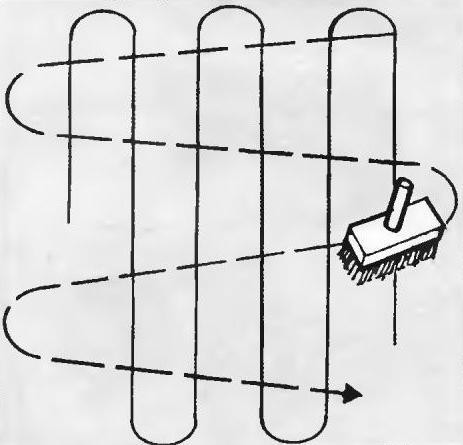 Scheme of cross movement of the roller whenapplying glue to the wall. There are methods that allow you to get minimal visibility of joints. Let's list them. Method one: asymmetrical connection of vertical stripes It may seem that alternating wallpaper stripes is a designer's idea, an option for decorating the interior. In fact, behind such a purpose there are many applied functions, including hiding the inconveniences of the layout. Situations that simply cannot do without a combination:
Scheme of cross movement of the roller whenapplying glue to the wall. There are methods that allow you to get minimal visibility of joints. Let's list them. Method one: asymmetrical connection of vertical stripes It may seem that alternating wallpaper stripes is a designer's idea, an option for decorating the interior. In fact, behind such a purpose there are many applied functions, including hiding the inconveniences of the layout. Situations that simply cannot do without a combination:
High walls in a small space.
Disproportionate length and width (for example, the room is narrow and long), which creates obvious difficulties when arranging furniture.
Visual combination of adjacent rooms (for example, a living room and a kitchen).
Delineation of functional areas in a large room, without attracting furnishings and other accessories.
Accent an interior element or just one wall, serving as a background for a design composition.
Method two: horizontal combination of large and small patterns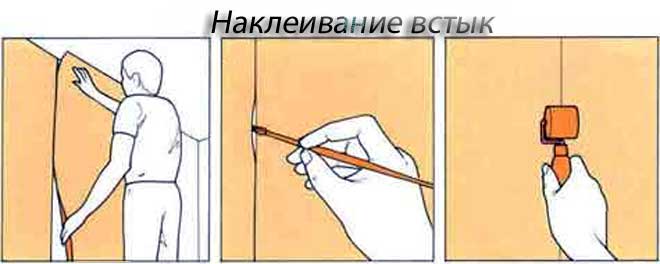 Scheme of correct finishing of walls end-to-end.To glue wallpaper without any visible joints, you can use this simple option at first glance. The walls are divided horizontally into two components (not necessarily uniform) and pasted over with companion wallpaper. This combination option will make the ceilings in the room less high. A more classic option is to combine plain and striped materials or small and large patterns. In most situations, the wall surface is divided in a ½ ratio and, in accordance with the designer's mood, pasted over either from top to bottom or from bottom to top (in a 2/3-1/3 ratio). A decorative molding, border, or strip can act as a delimiter between stripes of different types of materials. One of them is chosen based on the thickness of the materials and the design of the room. Method three: joining different wallpapers vertically Another option for gluing wallpaper end to end on walls is known - with their vertical separation.
Scheme of correct finishing of walls end-to-end.To glue wallpaper without any visible joints, you can use this simple option at first glance. The walls are divided horizontally into two components (not necessarily uniform) and pasted over with companion wallpaper. This combination option will make the ceilings in the room less high. A more classic option is to combine plain and striped materials or small and large patterns. In most situations, the wall surface is divided in a ½ ratio and, in accordance with the designer's mood, pasted over either from top to bottom or from bottom to top (in a 2/3-1/3 ratio). A decorative molding, border, or strip can act as a delimiter between stripes of different types of materials. One of them is chosen based on the thickness of the materials and the design of the room. Method three: joining different wallpapers vertically Another option for gluing wallpaper end to end on walls is known - with their vertical separation.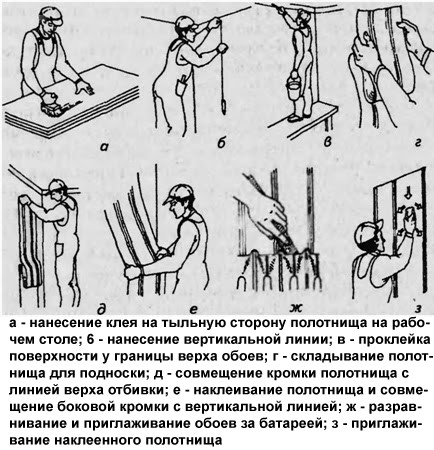 The procedure for gluing wallpaper.
The procedure for gluing wallpaper.
Uniform combination of two colors or textures, while the stripes alternate after one or two.
To visually increase the width of the roomThey use asymmetrical alternation: the surfaces are covered with background material, and then wide stripes with an accent shade are glued to the walls that require expansion (on one wall - in the center, on the other - near the corner).
Symmetry. In both directions from the middle of the room on the long walls are glued two strips with a bright tint or outstanding texture. This method allows you to visually shorten the length of the room.
"Accent wall" is a technique for verticalcombinations. One of the walls, which lacks dynamics or which acts as a background for the main interior element, is covered with a brightly colored material that looks advantageous among the other color options in the room.
Return to Contents</a>
Instructions for seamless gluing of different types of wallpaper
 Scheme for pasting wallpaper in corners.
Scheme for pasting wallpaper in corners.
Paper. Lap glued about 0.5 cm. On the floor roll out the wallpaper and apply glue on it. Then evenly apply to the surface of the wall and smooth. Bonding paper strips is a lot of trouble. Their quality is much lower than that of other types of wallpaper finishing, so their cost is appropriate. It is not allowed to linger here, especially when the glue is already applied to the canvas. It is important not to allow deformation of the paper. For this, you should carefully read the recommendations in the attached instructions.
Flizelin-vinyl. They have the quality of the middle class, the cost is within affordable. Since the wallpaper is completely safe, they are allowed to glue even in the child's room. They are more durable than paper, but they are inferior to vinyl. Cloths are glued lapped at approximately 0.1-0.2 cm. If the glue is applied directly to the wall, then glue it to the joint. Flizelin-vinyl materials can be painted with water-based paint.
Vinyl. They paste the easiest, and do it by butt, leaving no gaps between the sheets. Use a special vinyl adhesive for covering heavy wallpaper. The glue is applied solely to the wall, but not to the canvas. The procedure of gluing takes very little time. This species does not stretch, does not tear, it fits well on the wall, however it dries long. After gluing, make sure that there are no drafts in the room. Otherwise you can see the wallpaper on the floor.
Return to Contents</a>
How to properly glue the joints?
There are no special secrets in this matter.exists. Experience comes with practice. Many specialists combine the canvases automatically or intuitively. Although in general, from the eyes of an outside observer, this procedure may look like this. They begin to glue each new strip from the joint, trying to fit it as tightly as possible. If a small empty space is formed in some place, it is removed later. The next step is to straighten the canvas, it is not worth fixing it thoroughly at this point yet, since removing all the glue from under it will deprive the wallpaper of the ability to slide on the surface, and then the two canvases joined together will still come apart after drying. After straightening the canvas, the joint itself is pulled up using your palms or a plastic spatula. At the same time, they try to squeeze out the remaining glue in the direction of the joint. It is important not to stretch the wallpaper too much and not to press hard on it. This point is especially true for thin products. The above describes how wallpaper should be pasted onto the walls at the joints. There should be no misunderstandings.
Comments
comments
 Scheme for calculating wallpaper for a room.Experts claim that the results of pasting are affected by: 70% - the quality of the wallpaper itself and 30% - the skill of the performer. There are quite a few situations when joints are formed, no matter how much effort is put into leveling them. And it is not about skill at all. Pasting technology can be carried out according to the rules, but the properties of the purchased type of wallpaper will affect. This fact should be accepted as a given. By the way, the price of a roll is not always a guide to quality. These nuances should be taken into account. Therefore, it would not be superfluous to arm yourself with some information when starting to choose a material.
Scheme for calculating wallpaper for a room.Experts claim that the results of pasting are affected by: 70% - the quality of the wallpaper itself and 30% - the skill of the performer. There are quite a few situations when joints are formed, no matter how much effort is put into leveling them. And it is not about skill at all. Pasting technology can be carried out according to the rules, but the properties of the purchased type of wallpaper will affect. This fact should be accepted as a given. By the way, the price of a roll is not always a guide to quality. These nuances should be taken into account. Therefore, it would not be superfluous to arm yourself with some information when starting to choose a material. To make the joints on the surface less noticeable, it is recommended to paint the areas of the intended seams with paint of the corresponding shade.
To make the joints on the surface less noticeable, it is recommended to paint the areas of the intended seams with paint of the corresponding shade. Scheme of cross movement of the roller whenapplying glue to the wall. There are methods that allow you to get minimal visibility of joints. Let's list them. Method one: asymmetrical connection of vertical stripes It may seem that alternating wallpaper stripes is a designer's idea, an option for decorating the interior. In fact, behind such a purpose there are many applied functions, including hiding the inconveniences of the layout. Situations that simply cannot do without a combination:
Scheme of cross movement of the roller whenapplying glue to the wall. There are methods that allow you to get minimal visibility of joints. Let's list them. Method one: asymmetrical connection of vertical stripes It may seem that alternating wallpaper stripes is a designer's idea, an option for decorating the interior. In fact, behind such a purpose there are many applied functions, including hiding the inconveniences of the layout. Situations that simply cannot do without a combination: Scheme of correct finishing of walls end-to-end.To glue wallpaper without any visible joints, you can use this simple option at first glance. The walls are divided horizontally into two components (not necessarily uniform) and pasted over with companion wallpaper. This combination option will make the ceilings in the room less high. A more classic option is to combine plain and striped materials or small and large patterns. In most situations, the wall surface is divided in a ½ ratio and, in accordance with the designer's mood, pasted over either from top to bottom or from bottom to top (in a 2/3-1/3 ratio). A decorative molding, border, or strip can act as a delimiter between stripes of different types of materials. One of them is chosen based on the thickness of the materials and the design of the room. Method three: joining different wallpapers vertically Another option for gluing wallpaper end to end on walls is known - with their vertical separation.
Scheme of correct finishing of walls end-to-end.To glue wallpaper without any visible joints, you can use this simple option at first glance. The walls are divided horizontally into two components (not necessarily uniform) and pasted over with companion wallpaper. This combination option will make the ceilings in the room less high. A more classic option is to combine plain and striped materials or small and large patterns. In most situations, the wall surface is divided in a ½ ratio and, in accordance with the designer's mood, pasted over either from top to bottom or from bottom to top (in a 2/3-1/3 ratio). A decorative molding, border, or strip can act as a delimiter between stripes of different types of materials. One of them is chosen based on the thickness of the materials and the design of the room. Method three: joining different wallpapers vertically Another option for gluing wallpaper end to end on walls is known - with their vertical separation. The procedure for gluing wallpaper.
The procedure for gluing wallpaper. Scheme for pasting wallpaper in corners.
Scheme for pasting wallpaper in corners.

